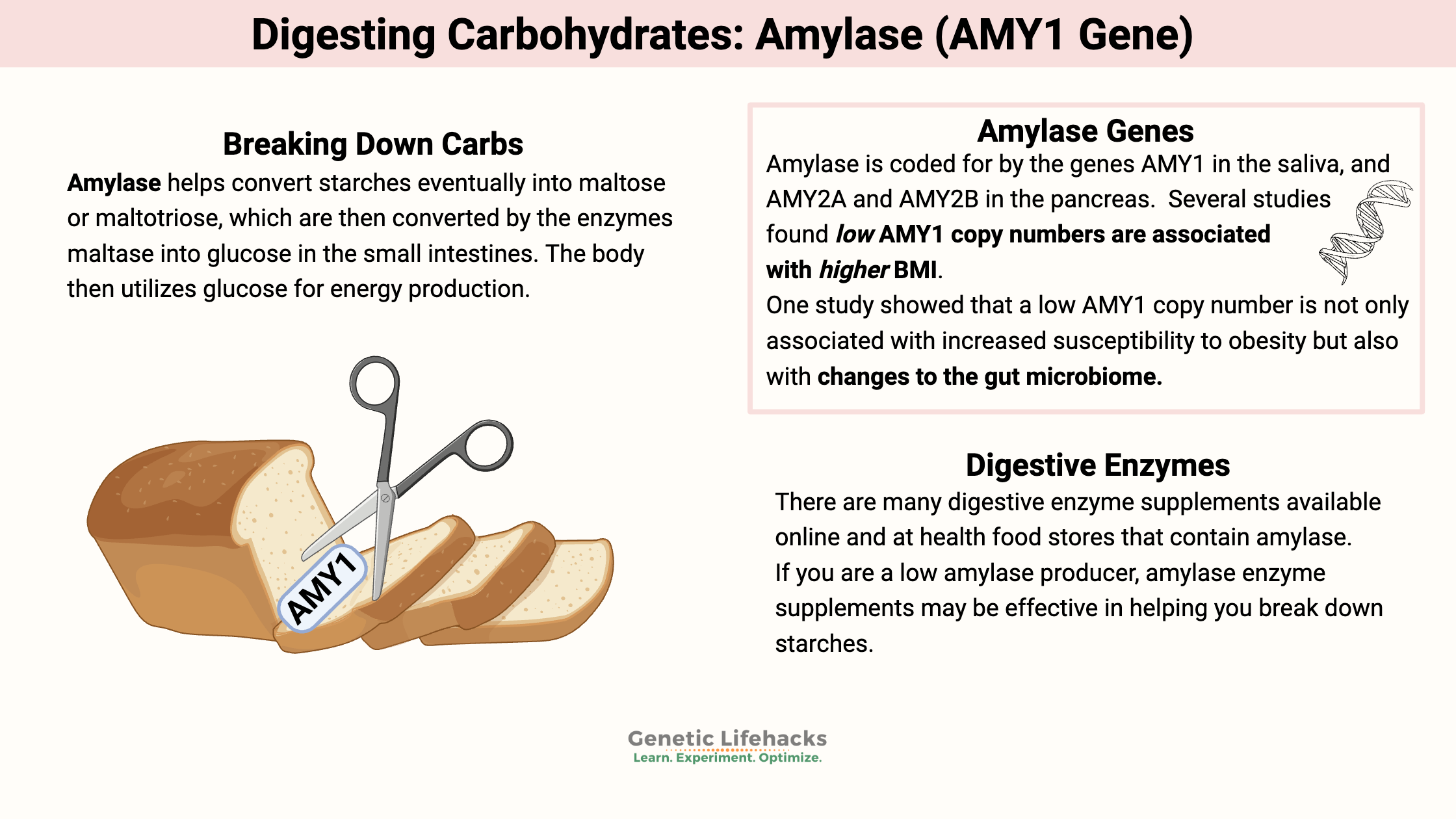Carbohydrate digestion begins in the mouth with an enzyme called amylase. Saliva mixes with your food as you chew it, and the amylase in saliva breaks down carbohydrates into simple sugars. Amylase is also produced by the pancreas and used for further breaking down carbs in the small intestines.
This article explains how the amylase enzyme works, genetic variants that impact your production of amylase, and solutions if you are low in amylase.
Breaking down carbohydrates:
While amylase isn’t the only enzyme involved in breaking down carbohydrates, it is the first step. Amylase helps convert starches eventually into maltose or maltotriose, which are then converted by the enzymes maltase into glucose in the small intestines. The body then utilizes glucose for energy production.
Interesting side note: Vampire bats are the only mammals not to produce maltase.
Amylase genes, weight, and carbs:
Amylase is coded for by the genes AMY1 in the saliva, and AMY2A and AMY2B in the pancreas. These genes vary widely in the number of copies of the gene that a person can have. For example, the AMY1 gene can vary between 2 and 17 copies, thus giving a wide variation in the amount of amylase a person normally secretes in their saliva.[ref]
Several studies found low AMY1 copy numbers are associated with higher BMI.[ref][ref][ref] In contrast, a study published in Nature Genetics in 2015 found no association between amylase copy numbers and BMI.
Let’s look at this more in-depth to see what is going on…
A 2019 study of overweight and obese children in Alabama found that children who were overweight/obese had an average of 6 copies of the aMY1 gene – compared with normal-weight children who had an average of 8 copies of the AMY1 gene. This correlation was even stronger in African American children.[ref]
Another study in Qatar found that high salivary amylase correlated with a low risk of obesity.[ref]
Part of the discrepancy between studies may be differences in diet in the populations – perhaps it is a mismatch between the percentage of carbs in the diet and the ability to break down carbohydrates that cause an increase in BMI.
One study showed that a low AMY1 copy number is not only associated with increased susceptibility to obesity but also with changes to the gut microbiome. Children with low AMY copy numbers also had lower numbers of Prevotella bacteria.[ref] A higher ratio of Prevotella to Bacteroides bacteria in the gut microbiome is linked to more significant weight loss.[ref]
Evolutionary theory on amylase and agriculture:
In the past, researchers theorized that people adapted multiple copies of amylase after humans transitioned from hunter-gatherers to agricultural societies.
DNA evidence, though, showed this to be incorrect. The ancient DNA from 8,000-year-old hunter-gatherer skeletons in Europe showed that the Mesolithic residents had a high level of amylase (high copy number for the AMY1 gene). Since this population was still hunter-gatherers and not agrarian, the DNA evidence has put a damper on the prior theories. Other DNA studies point to the high amylase production being evident since Neanderthals intermixed with Homo sapiens.[ref]
What else does research show about amylase?
- Cellulose can inhibit amylase activity.[ref] This makes me wonder if the presence of cellulose gum in processed food products makes a difference in how we break down processed foods?
- Tannins in sorghum reduce amylase activity.[ref]
- Tea polyphenols also inhibit amylase.[ref]
- Lower amylase activity is associated with higher reliance on fatty acids for energy.[ref]
- Higher amylase activity was associated with lower blood glucose concentration after eating starch in a small study (14 people).[ref]
23andMe and AncestryDNA data do not give copy number variation information, but several studies have linked specific SNPs to higher or lower amylase activity and copies of the gene.
AMY1-AMY2 Genotype Report:
Lifehacks
Supplements: Digestive Enzymes
There are many digestive enzyme supplements available online and at health food stores that contain amylase.
If you are a low amylase producer, you may want to experiment and see whether an amylase enzyme supplement at mealtime is effective in helping you break down starches.
Blood glucose level regulation:
Related Articles and Topics:
Hunter-Gatherer vs. Farmer Genes
Our ancient ancestors lived much differently than we do today. They were hunter-gatherers, living off of fish, meat, and plant foods that they gathered. A huge shift occurred when those hunter-gatherers began farming, growing grains, and storing them so that food would be available all year. Learn if you carry the hunter-gatherer or farmer gene variant.
Mushroom Intolerance
Mushrooms contain a healthy antioxidant called ergothioneine. But for people with an OCTN1 genetic variant, this antioxidant can be too much of a good thing, leading to intestinal problems. Check your genetic data to see if you carry this mushroom intolerance variant.

